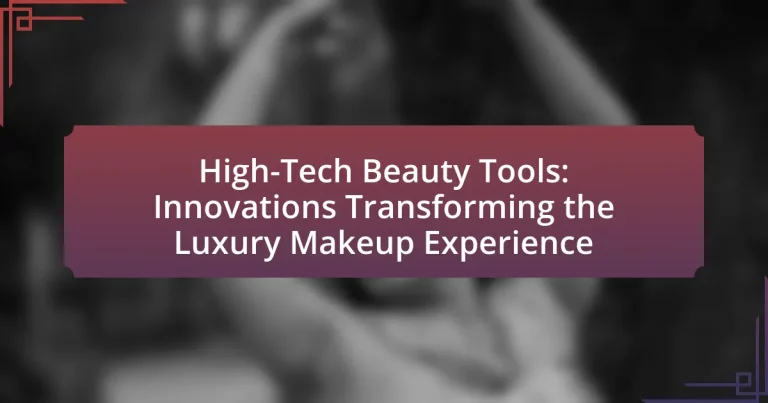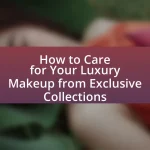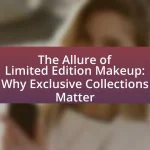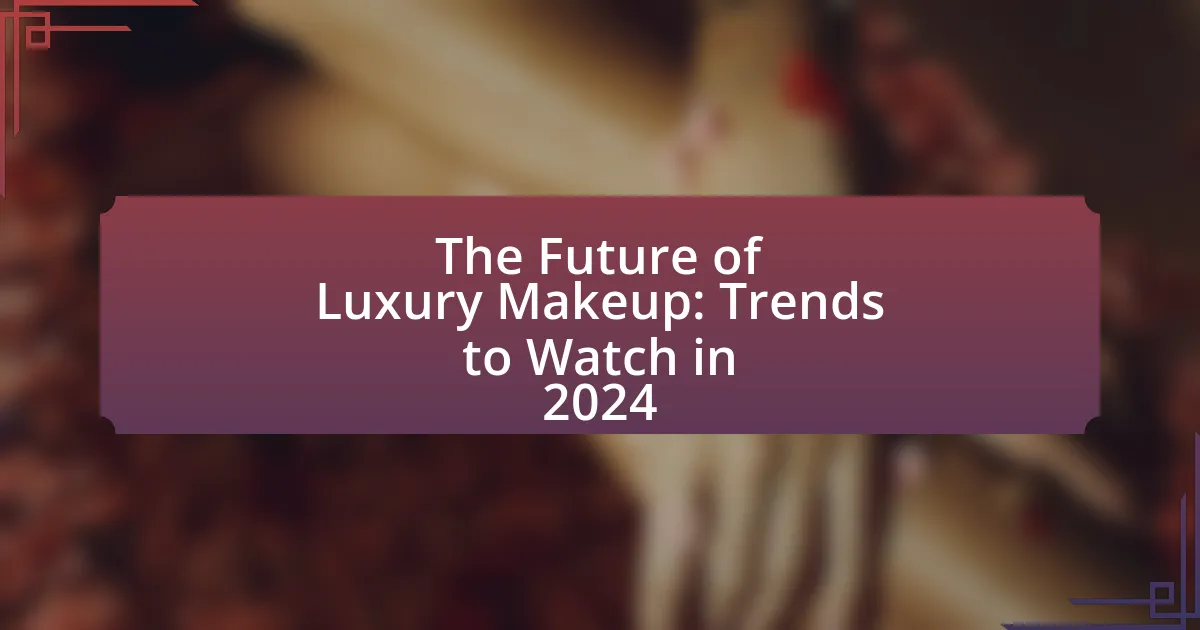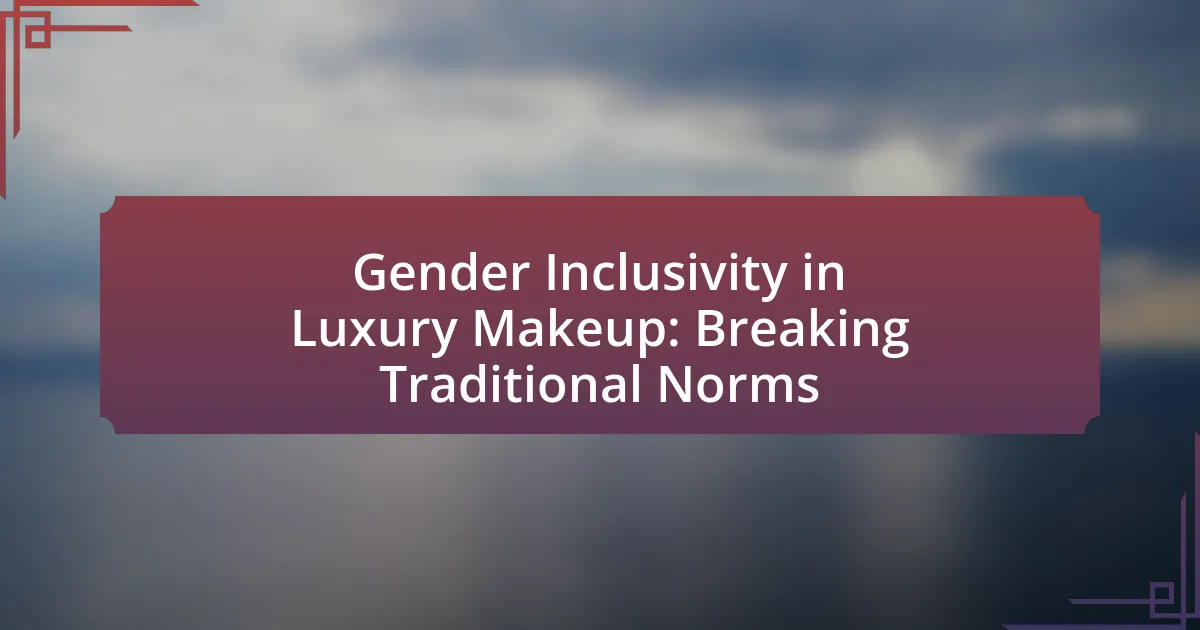High-tech beauty tools represent a significant advancement in the beauty industry, utilizing innovative technologies such as LED light therapy, ultrasonic vibrations, and artificial intelligence to enhance skincare and makeup application. These devices provide personalized treatments, improve product absorption, and streamline the makeup process, catering to the growing demand for customized beauty solutions. The article explores the technologies behind these tools, their impact on luxury makeup experiences, and the trends driving their popularity in the market. Additionally, it discusses the benefits of integrating skincare with makeup application and offers practical tips for maximizing the effectiveness of these high-tech devices.
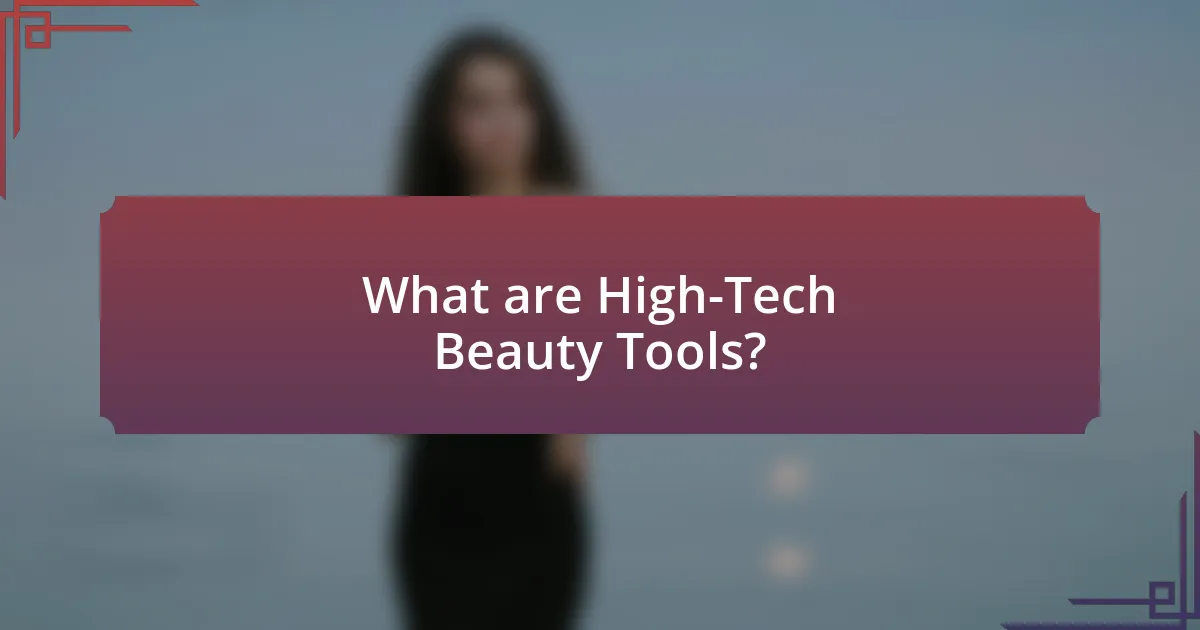
What are High-Tech Beauty Tools?
High-tech beauty tools are advanced devices that utilize innovative technology to enhance skincare and makeup application. These tools often incorporate features such as LED light therapy, ultrasonic vibrations, and smart sensors to provide personalized beauty treatments. For example, devices like facial cleansing brushes and microcurrent machines have been shown to improve skin texture and firmness, as supported by studies indicating their effectiveness in promoting collagen production and enhancing product absorption.
How do High-Tech Beauty Tools enhance the luxury makeup experience?
High-tech beauty tools enhance the luxury makeup experience by providing precision, personalization, and efficiency in application. These tools, such as smart makeup brushes and skin analysis devices, utilize advanced technology to analyze skin types and recommend tailored products, ensuring optimal results. For instance, devices like the Foreo UFO use LED light therapy and sonic pulsations to enhance the effectiveness of skincare products, demonstrating a blend of luxury and innovation. Additionally, tools equipped with AI can offer real-time feedback on makeup application techniques, elevating the overall experience by making it more interactive and customized.
What technologies are commonly used in High-Tech Beauty Tools?
High-tech beauty tools commonly utilize technologies such as LED light therapy, ultrasonic waves, microcurrent, and artificial intelligence. LED light therapy is employed for skin rejuvenation and acne treatment, using specific wavelengths to target various skin concerns. Ultrasonic waves are used in devices for deep cleansing and enhancing product absorption, operating at high frequencies to remove impurities. Microcurrent technology stimulates facial muscles, promoting a lifted appearance and improved skin tone. Artificial intelligence is increasingly integrated into beauty tools for personalized skincare recommendations and virtual try-ons, enhancing user experience and effectiveness. These technologies collectively represent the forefront of innovation in the beauty industry, driving advancements in skincare and makeup application.
How do these technologies improve makeup application?
Technologies improve makeup application by enhancing precision, personalization, and efficiency. For instance, augmented reality (AR) tools allow users to virtually try on makeup products, ensuring they select shades that complement their skin tone before purchase. Additionally, smart makeup brushes equipped with sensors can analyze skin type and recommend suitable products, leading to a more tailored application. Studies show that these innovations not only streamline the makeup process but also reduce product waste, as users are less likely to purchase items that do not suit them.
Why are High-Tech Beauty Tools becoming popular in the luxury market?
High-tech beauty tools are becoming popular in the luxury market due to their ability to deliver advanced skincare and makeup solutions that enhance user experience and results. These tools often incorporate cutting-edge technology, such as artificial intelligence and skin analysis, which provide personalized treatments and improve efficacy. For instance, devices like LED masks and ultrasonic skin cleansers have been shown to offer professional-grade results at home, appealing to consumers seeking convenience and effectiveness. The luxury market is particularly drawn to these innovations as they align with the growing demand for high-quality, results-driven products that offer a unique and elevated beauty experience.
What trends are driving the demand for High-Tech Beauty Tools?
The demand for high-tech beauty tools is primarily driven by the increasing consumer preference for personalized skincare solutions. This trend is fueled by advancements in technology, such as artificial intelligence and skin analysis tools, which allow users to tailor their beauty routines to their specific needs. Additionally, the rise of social media influencers and beauty tutorials has heightened awareness and interest in innovative beauty gadgets, leading to greater consumer engagement and investment in high-tech products. According to a report by Grand View Research, the global beauty devices market is expected to reach $107.5 billion by 2025, highlighting the significant growth potential in this sector.
How do consumer preferences influence the development of these tools?
Consumer preferences significantly influence the development of high-tech beauty tools by driving innovation and shaping product features. As consumers increasingly seek personalized and efficient beauty solutions, companies respond by integrating advanced technologies such as artificial intelligence and skin analysis into their products. For instance, a survey by Statista in 2022 indicated that 70% of consumers prioritize products that offer customization options, prompting brands to develop tools that cater to individual skin types and preferences. This alignment with consumer desires not only enhances user satisfaction but also fosters brand loyalty, ultimately guiding the direction of future innovations in the beauty tech industry.
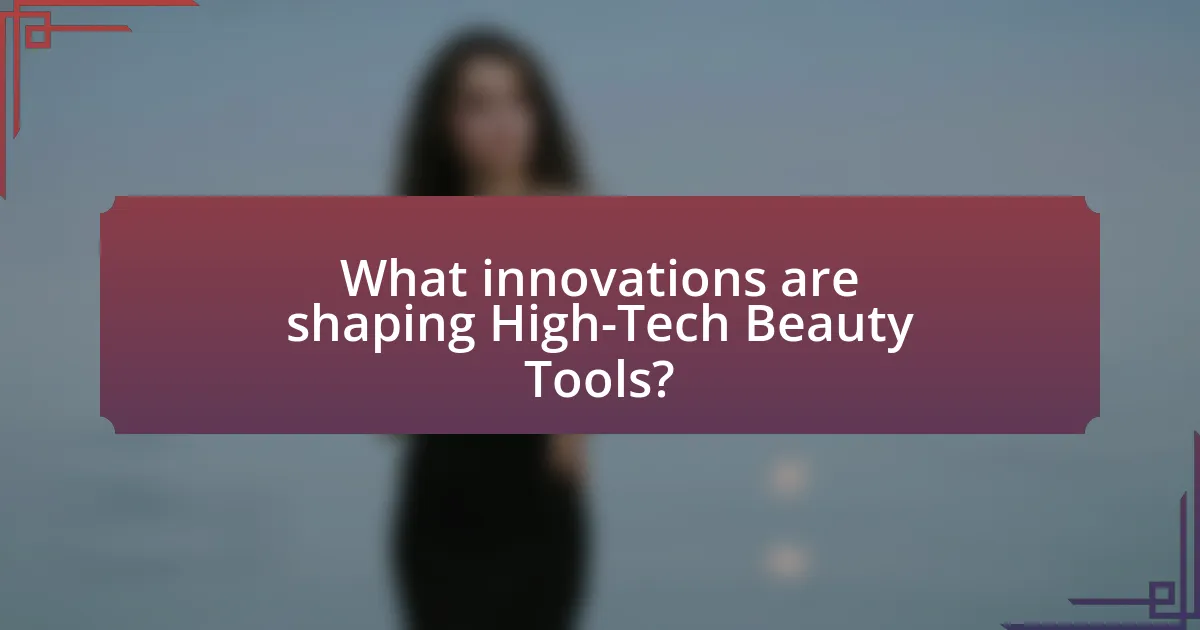
What innovations are shaping High-Tech Beauty Tools?
Innovations shaping high-tech beauty tools include artificial intelligence, skin analysis technology, and smart devices. Artificial intelligence enhances personalized skincare by analyzing individual skin types and recommending tailored products, as seen in tools like the L’Oréal Perso. Skin analysis technology, such as handheld devices that assess skin conditions in real-time, allows users to track changes and adjust their routines accordingly. Additionally, smart devices, like connected makeup applicators, provide precise application and real-time feedback, improving user experience and results. These advancements are supported by market trends indicating a growing demand for personalized beauty solutions, with the global beauty tech market projected to reach $10 billion by 2026.
How is artificial intelligence utilized in High-Tech Beauty Tools?
Artificial intelligence is utilized in high-tech beauty tools primarily to enhance personalization and improve user experience. AI algorithms analyze individual skin types, preferences, and makeup styles to recommend tailored beauty solutions, such as specific products or application techniques. For instance, tools like smart mirrors use AI to assess skin conditions and provide real-time feedback, enabling users to make informed decisions about their beauty routines. Additionally, AI-driven applications can simulate makeup looks on users’ images, allowing for virtual try-ons that increase consumer confidence in product choices. These innovations demonstrate how AI is reshaping the luxury makeup experience by making it more customized and interactive.
What are the benefits of AI in personalized makeup applications?
AI enhances personalized makeup applications by providing tailored recommendations based on individual skin tones, facial features, and preferences. This technology analyzes user data through advanced algorithms, ensuring that makeup products and techniques are optimized for each person. For instance, AI-driven applications can assess skin conditions and suggest suitable products, improving user satisfaction and reducing the likelihood of adverse reactions. Additionally, studies show that personalized recommendations can increase consumer confidence and engagement, leading to higher sales in the beauty industry.
How does AI enhance user experience with High-Tech Beauty Tools?
AI enhances user experience with high-tech beauty tools by providing personalized recommendations and optimizing product performance. For instance, AI algorithms analyze user data, such as skin type and preferences, to suggest tailored beauty routines and products, improving satisfaction and effectiveness. Additionally, AI-driven features like virtual try-ons and skin analysis tools allow users to visualize results before purchase, leading to informed decisions. Research indicates that 70% of consumers are more likely to purchase a product after using virtual try-on technology, demonstrating the significant impact of AI on enhancing user engagement and confidence in high-tech beauty tools.
What role does augmented reality play in High-Tech Beauty Tools?
Augmented reality (AR) enhances high-tech beauty tools by providing users with interactive and immersive experiences for makeup application and skincare analysis. AR technology allows consumers to visualize how different products will look on their skin in real-time, facilitating informed purchasing decisions. For instance, brands like L’Oréal and Sephora utilize AR in their apps to enable virtual try-ons, which have been shown to increase customer engagement and satisfaction. According to a study by the National Retail Federation, 61% of consumers prefer retailers that offer AR experiences, highlighting its significant impact on the luxury makeup experience.
How can augmented reality assist in makeup trials?
Augmented reality can assist in makeup trials by allowing users to virtually apply makeup products in real-time using their device’s camera. This technology enables consumers to see how different shades and styles look on their own faces without the need for physical application, enhancing the shopping experience. According to a study by the National Retail Federation, 61% of consumers prefer to shop at retailers that offer augmented reality experiences, indicating a strong demand for such innovations in the beauty industry.
What are the limitations of augmented reality in beauty applications?
The limitations of augmented reality in beauty applications include issues with accuracy, user experience, and technology accessibility. Accuracy can be compromised due to variations in lighting, skin tone, and facial features, which may lead to unrealistic representations of products. User experience can be hindered by the need for high-quality hardware and software, which not all consumers possess, limiting widespread adoption. Additionally, the technology may not account for real-world factors such as texture and finish, making it difficult for users to gauge how products will look in reality. These limitations highlight the challenges that augmented reality faces in delivering a fully immersive and reliable beauty experience.
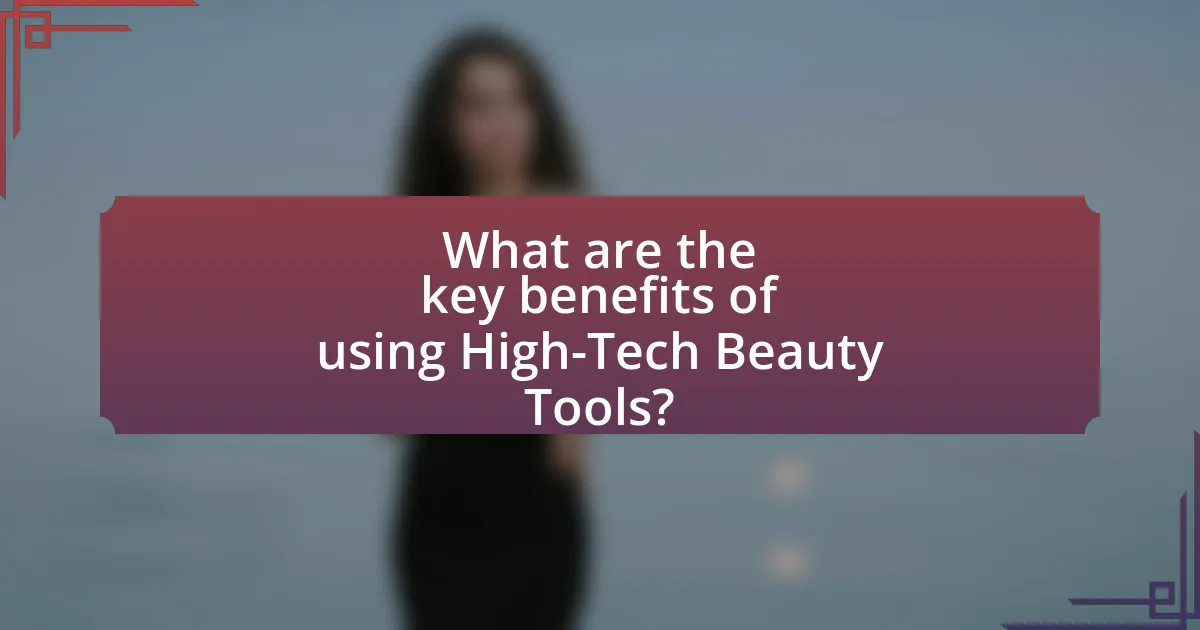
What are the key benefits of using High-Tech Beauty Tools?
High-tech beauty tools offer enhanced precision and effectiveness in skincare and makeup application. These tools often utilize advanced technologies such as LED light therapy, ultrasonic waves, and microcurrent stimulation, which can improve skin texture, reduce signs of aging, and enhance product absorption. For instance, studies have shown that microcurrent devices can increase collagen production by up to 40%, leading to firmer skin. Additionally, high-tech beauty tools often provide personalized experiences through app integration, allowing users to track their skin’s progress and tailor treatments to their specific needs. This combination of technology and personalization results in more efficient and effective beauty routines.
How do High-Tech Beauty Tools improve makeup accuracy?
High-tech beauty tools improve makeup accuracy by utilizing advanced technologies such as artificial intelligence, augmented reality, and precision engineering. These tools, like smart makeup applicators and virtual try-on apps, analyze facial features and skin tones to provide personalized recommendations and application techniques. For instance, AI-driven devices can measure the exact amount of product needed for a flawless finish, reducing the likelihood of over-application or uneven coverage. Studies have shown that users of augmented reality makeup apps report a 70% increase in satisfaction with their makeup application, highlighting the effectiveness of these technologies in enhancing precision and overall results.
What specific features contribute to enhanced precision in makeup application?
Specific features that contribute to enhanced precision in makeup application include ergonomic brush designs, advanced blending technology, and customizable settings in electronic tools. Ergonomic brush designs allow for better control and comfort, enabling users to apply makeup with accuracy. Advanced blending technology, such as airbrush systems, provides a seamless finish by distributing product evenly across the skin. Customizable settings in electronic tools, like smart makeup applicators, allow users to adjust pressure and speed, further enhancing precision. These features collectively improve the overall makeup application experience, ensuring a flawless look.
How do these tools minimize common makeup mistakes?
High-tech beauty tools minimize common makeup mistakes by providing precision and automation in application. For instance, devices like smart makeup brushes and airbrush systems ensure even distribution of products, reducing the likelihood of streaks or uneven coverage. Additionally, augmented reality apps allow users to virtually try on makeup, helping them visualize how colors and styles will look before application, thereby preventing mismatched shades or unsuitable looks. These innovations leverage technology to enhance accuracy and user experience, significantly decreasing the chances of errors that often occur with traditional methods.
What impact do High-Tech Beauty Tools have on skincare routines?
High-tech beauty tools significantly enhance skincare routines by providing advanced functionalities that improve product absorption and skin health. These tools, such as LED masks, microcurrent devices, and ultrasonic cleansers, utilize technology to deliver targeted treatments that can stimulate collagen production, reduce inflammation, and enhance the efficacy of skincare products. For instance, a study published in the Journal of Cosmetic Dermatology found that microcurrent therapy can increase collagen synthesis by up to 40%, demonstrating the tangible benefits of incorporating such devices into daily skincare practices.
How can these tools integrate skincare with makeup application?
High-tech beauty tools can integrate skincare with makeup application by combining advanced formulations and technologies that enhance both skin health and cosmetic performance. For instance, devices like smart makeup applicators can deliver skincare ingredients such as hyaluronic acid or peptides while applying foundation, ensuring that the skin receives hydration and nourishment simultaneously. Additionally, some tools utilize LED light therapy or ultrasonic waves to improve skin texture and promote absorption of skincare products during makeup application. Research indicates that these integrated approaches not only streamline the beauty routine but also improve the overall effectiveness of both skincare and makeup, leading to healthier skin and a more flawless finish.
What are the long-term benefits of using High-Tech Beauty Tools for skin health?
The long-term benefits of using high-tech beauty tools for skin health include improved skin texture, enhanced collagen production, and reduced signs of aging. These tools, such as LED light therapy devices and microcurrent machines, stimulate cellular activity and promote skin rejuvenation. Research indicates that consistent use of these technologies can lead to a 30% increase in collagen levels over time, resulting in firmer and more youthful skin. Additionally, high-tech beauty tools can help in the reduction of fine lines and wrinkles, with studies showing a significant decrease in wrinkle depth after regular treatments.
What are some practical tips for using High-Tech Beauty Tools effectively?
To use high-tech beauty tools effectively, ensure you follow the manufacturer’s instructions for optimal results. Familiarizing yourself with the specific features and settings of each tool enhances performance and safety. For instance, using a facial cleansing device requires understanding the appropriate speed and duration for your skin type to avoid irritation. Additionally, regularly cleaning and maintaining these tools prolongs their lifespan and ensures hygiene, as studies show that unclean devices can harbor bacteria, leading to skin issues. Lastly, integrating these tools into a consistent skincare routine maximizes their benefits, as consistent use has been linked to improved skin texture and appearance.
How can users maximize the benefits of their High-Tech Beauty Tools?
Users can maximize the benefits of their high-tech beauty tools by following the manufacturer’s guidelines for usage and maintenance. Proper usage ensures that the tools operate at their optimal performance, which can enhance results such as improved skin texture or more effective makeup application. Regular maintenance, including cleaning and charging, prolongs the lifespan of the devices and maintains their efficacy. For instance, studies show that tools like LED masks and ultrasonic skin scrubbers yield better results when used consistently and correctly, as recommended by dermatologists.
What common mistakes should users avoid when using these tools?
Users should avoid improper usage of high-tech beauty tools, as this can lead to ineffective results or skin damage. Common mistakes include not reading the user manual, which often contains essential instructions for safe and effective use, and failing to clean the tools regularly, which can cause skin irritation or infections. Additionally, users should avoid using these tools on sensitive areas without proper guidance, as this can exacerbate skin issues. Lastly, neglecting to adjust settings according to skin type can result in adverse effects, as many tools are designed with customizable features to cater to different skin needs.
